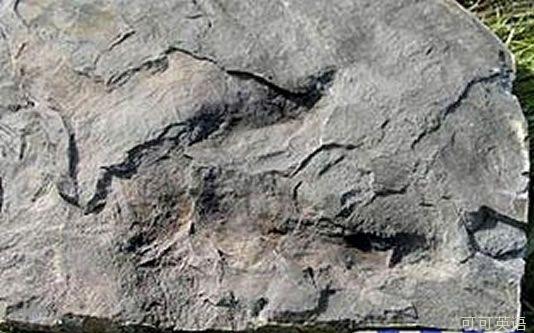
Science and Technology Palaeontology Do the locomotion
科技 古生物學 活動活動
The earliest animal tracks yet found have been unearthed in Canada
在加拿大出土了迄今為止發現的最早動物足跡
ONE of the greatest mysteries of the history of life is the Cambrian explosion.
寒武紀的大爆炸是生命史中最大的謎團之一。
Prior to 560m years ago, animal fossils are rare.
5.6億年以前的動物化石寥寥無幾。
Then, in a geological eyeblink, they become common.
然而,只過了地質史上一瞬間的功夫,它們便多得不足為奇了。
Shelly creatures such as trilobites and brachiopods, of whose ancestors there is little sign in the rocks, are suddenly everywhere.
像三葉蟲、腕足動物此般殼類動物的祖先沒有在巖層中留下什么痕跡,但它們的遺跡卻突然間比比皆是。
Biologists would dearly love to know what happened.
生物學家們迫不及待地想知道當時到底發生了什么。
Recent discoveries at the delightfully named Mistaken Point, in Newfoundland, serve to lift the veil slightly.
紐芬蘭島上有個地方名字很有趣,叫“錯誤點”,正是最近在這里的一些發現輕輕掀起了這個神秘面紗的一角。
These findings are not of Precambrian animals themselves, but of their tracks. And these, paradoxically, may be more useful.
發現的并不是寒武紀前的動物本身,而是它們的足跡。而出人意料的是,這些足跡可能還更有用。
Alexander Liu of Oxford University and his colleagues took an interest in Mistaken Point because it is a site known for so-called Ediacaran fossils, shell-less animals of unknown provenance that slightly predate the Cambrian.
牛津大學的亞歷山大?劉和他的同事們之所以對“錯誤點”產生興趣,是因為它因埃迪卡拉動物化石而聞名,埃迪卡拉動物是存在于略早于寒武紀時期的緣起不明的無殼動物。
As Mr Liu and his team explored the rocks they came across more than 70 markings that looked like tracks—slight impressions in the sediment with tiny ridges sticking up along the sides.
在劉和他的團隊對那里的巖石進行勘察的過程中,他們發現了70多個類似足跡的斑點——在沉淀物中的一些淺痕,其周邊有輕微的突起。
These markings, they report in Geology, are up to 13mm wide and up to 17cm long.
據他們在《地質學》雜志中的報告,這些斑點寬不過13毫米,長不過17厘米。
What is most curious about these tracks is that the rock they are in is reckoned to have formed at least a kilometre below sea level.
更奇特的是,據估計,這些足跡所在的巖石是在海平面至少一千米以下形成的。
Fossil bodies might get into such rock by sinking to the sea floor.
化石體倒是可能會沉到海底而進入這塊巖石。
Tracks, however, must have been made by something that was alive.
然而,只有活的東西才能留下足跡。
Precambrian animals must therefore have lived at such depths.
因此,前寒武紀的動物肯定曾經生活在這么深的地方。
The tracks also cast light on what the Ediacarans actually were.
這些足跡也使我們了解了埃迪卡拉動物到底是什么。
Some palaeontologists think them members of a phylum that is now extinct.
有的古生物學家認為它們屬于已經絕跡的一門動物。
Others, though, believe they were Cnidarians, the group that includes modern sea anemones and jellyfish.
而有的則認為它們是刺胞動物,這是包括現代的海葵和海蜇在內的一門動物。
Cnidarians grow from embryos that have only two layers of cells.
刺胞動物是由只有兩層細胞的晶胚發展而來的。
Most animals, including all the shelly Cambrian ones, grow from three-layered embryos.
而包括所有寒武紀殼類動物在內的大多數動物都是由三層細胞的晶胚發展而來。
The tracks found by Mr Liu look suspiciously like those left by modern sea anemones which, despite their sedentary appearance, do move around slowly.
劉發現的這些足跡疑似現代的海葵的足跡。海葵雖然看起來不怎么活動,但它們確實會慢慢地四處游動。
That is not strong evidence that Ediacarans were Cnidarians, but it is something.
這雖然不能有力地證明埃迪卡拉動物屬于刺胞動物,但它的確是一個重要的發現。
Yet if that is the right interpretation, it leaves the question of what evolved into the trilobites and their kind as mysterious as ever.
不過倘若這樣的解釋是正確的,三葉蟲和它的同類由何而來的問題將仍然神秘晦澀,一如往昔。











